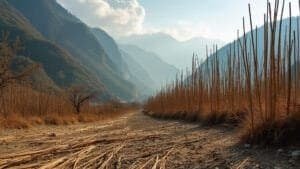Introduction
Rising temperatures caused by climate change pose significant long-term challenges for red pandas, affecting their health, habitats, and survival. Heat stress, bamboo decline, and habitat fragmentation are among the many issues threatening this already vulnerable species
Additionally, higher temperatures increase the risk of disease and disrupt reproduction, compounding the difficulties red pandas face in adapting to a rapidly changing environment
This article examines the long-term effects of rising temperatures on red panda health and explores conservation strategies to mitigate these impacts
Direct Impacts of Rising Temperatures on Red Panda Health
Rising global temperatures due to climate change have profound physiological and ecological implications for red pandas. These impacts, ranging from heat stress to increased disease prevalence, directly threaten their survival and long-term health
Heat Stress and Its Effects on Red Panda Physiology
Red pandas are naturally adapted to the cool, temperate forests of the eastern Himalayas and southwestern China
With their thick, fur-covered bodies and low metabolic rates, they are physiologically ill-equipped to cope with rising temperatures. Heat stress is a significant consequence of global warming and occurs when red pandas are unable to dissipate heat efficiently
Research from the Journal of Wildlife Physiology (2020) shows that sustained temperatures above 77°F (25°C) lead to signs of thermal discomfort in red pandas. These include increased respiratory rates, lethargy, and reduced appetite. Prolonged heat exposure can cause hyperthermia, weakening their immune system and making them more susceptible to infections
Heat stress also disrupts energy balance. Red pandas rely heavily on bamboo, a nutrient-poor food that requires high intake levels to meet their energy needs. During periods of heat stress, their reduced activity and diminished appetite can lead to malnutrition, compounding health issues
Increased Disease Risks From Higher Temperatures
Rising temperatures create conditions conducive to the proliferation of pathogens and parasites. Higher humidity and warmer climates allow the expansion of diseases that may not have previously posed significant threats to red pandas
For example, tick-borne diseases such as Lyme disease and bacterial infections caused by Ehrlichia species are expected to increase in prevalence as warmer temperatures expand tick habitats
Similarly, warmer conditions favor the growth of fungal pathogens like Aspergillus, which can cause respiratory infections in red pandas
Weakened immune systems due to heat stress further exacerbate these risks, reducing red pandas’ ability to fend off infections. Research published in Veterinary Microbiology (2021) emphasizes that captive and wild red panda populations alike face heightened vulnerability to emerging infectious diseases driven by climate change
How Temperature Changes Affect Reproduction and Survival
Reproduction is another aspect of red panda biology that is sensitive to rising temperatures. Red pandas typically breed in late winter or early spring, with cubs born during the summer months when bamboo is most abundant
However, shifts in seasonal temperature patterns can disrupt this reproductive cycle
For instance, warmer winters may lead to earlier mating seasons, which may not align with peak bamboo growth. This mismatch could result in insufficient food availability for nursing mothers and their cubs, leading to lower survival rates
Heat stress also affects reproductive success. Studies on captive red pandas show that elevated temperatures can reduce sperm quality in males and disrupt hormonal cycles in females. Over time, these factors may lead to decreased fertility, posing a significant challenge to population stability
By increasing physiological stress, disease susceptibility, and reproductive difficulties, rising temperatures directly compromise the health and viability of red panda populations, both in the wild and in managed care
Habitat and Dietary Challenges From Rising Temperatures
Rising temperatures not only affect the physiology of red pandas but also disrupt the ecosystems they depend on. Habitat degradation, bamboo decline, and extreme weather events driven by climate change create compounding challenges for red panda survival
Bamboo Decline and Nutritional Stress in Red Pandas
Bamboo is a critical component of the red panda’s diet, comprising up to 95% of their food intake. However, bamboo is highly sensitive to climate conditions, thriving only within specific temperature and moisture ranges
Rising temperatures directly threaten bamboo growth and availability, leading to nutritional stress for red pandas
A study published in Global Ecology and Conservation (2021) predicts that a 1.5°C rise in global temperatures could result in the loss of up to 40% of bamboo habitats in the eastern Himalayan region by 2050
Heatwaves, coupled with irregular precipitation, disrupt the growth cycles of bamboo, causing die-offs and reducing the regeneration of this essential resource
Bamboo’s periodic flowering and die-back cycles further exacerbate the problem. These cycles, already a natural challenge for red pandas, become more erratic under changing climate conditions
With fewer food sources available, red pandas may need to expand their ranges in search of sustenance, increasing energy expenditure and exposure to predators
Range Shifts: Adapting to a Changing Environment
As temperatures rise, red pandas are expected to shift their ranges to higher altitudes in search of cooler climates and suitable bamboo. While this adaptation may provide short-term relief, it is not without consequences
Higher elevations often have steeper terrain, limited space, and sparse vegetation, reducing the carrying capacity of these habitats. Additionally, many high-altitude regions lack the specific bamboo species that red pandas rely on, further limiting their ability to adapt
Range shifts also lead to increased competition with other wildlife. Species such as the Himalayan pika, which share overlapping habitats with red pandas, may compete for resources, further straining the ecosystem
In some cases, red pandas may encounter human settlements during their migrations, increasing the likelihood of human-wildlife conflict
Fragmentation of habitats exacerbates these challenges. Roads, agriculture, and deforestation create barriers that prevent red pandas from accessing suitable habitats, isolating populations and reducing genetic diversity
This fragmentation makes it harder for red pandas to respond effectively to climate-induced changes in their environment
Extreme Weather Events and Habitat Fragmentation
Rising global temperatures are linked to an increase in extreme weather events, including heavy rainfall, droughts, and storms, which further impact red panda habitats
For instance, intense rainfall and landslides in mountainous regions can destroy bamboo groves, uproot trees, and erode soil, rendering habitats unsuitable for red pandas. Droughts, on the other hand, reduce bamboo growth and availability, creating long-term food shortages
These events not only degrade habitats but also increase the risk of injury or death for red pandas. Flooding and landslides may directly harm individuals, while prolonged droughts can force red pandas into suboptimal habitats where survival is less certain
Habitat fragmentation caused by extreme weather and human activity further compounds these issues. Red pandas require large, connected territories to find food and shelter, and fragmented landscapes reduce their ability to navigate their environment effectively
Addressing these challenges requires a combination of habitat restoration, corridor creation, and proactive conservation planning to mitigate the effects of rising temperatures on red panda habitats
Mitigating the Effects of Climate Change on Red Pandas
Conservation efforts aimed at protecting red pandas must address the multifaceted challenges posed by rising temperatures
By preserving habitats, creating climate-resilient ecosystems, and employing adaptive strategies, it is possible to mitigate the impacts of climate change on this vulnerable species
Conservation Strategies for Protecting Red Pandas in Warming Climates
Habitat Restoration and Connectivity
Restoring degraded habitats is essential for red panda conservation. Reforestation projects focused on planting native tree species and bamboo help rebuild ecosystems and provide the resources red pandas need
Creating wildlife corridors is equally important. These corridors connect fragmented habitats, allowing red pandas to migrate safely to higher altitudes or alternative feeding grounds as temperatures rise
For example, conservation initiatives in Nepal’s Langtang National Park have established corridors linking isolated red panda populations, promoting genetic diversity and resilience
Monitoring and Research
Long-term monitoring of red panda populations and habitats is crucial for understanding the effects of rising temperatures. Technologies such as GPS telemetry, camera traps, and satellite imagery enable researchers to track range shifts, habitat use, and health trends
Data collected through these methods inform conservation plans, helping identify priority areas for protection and adaptive management. For example, tracking seasonal migrations can guide the creation of buffer zones around key habitats to protect red pandas from human disturbances
Community Engagement
Involving local communities in conservation efforts ensures the sustainability of red panda habitats. Community-based programs, such as agroforestry and sustainable farming practices, reduce deforestation and provide alternative livelihoods
Education initiatives that emphasize the importance of red pandas and their role in forest ecosystems foster a sense of stewardship among local populations
Programs like the Red Panda Network’s Forest Guardians in Nepal train community members to monitor red panda populations and mitigate threats, creating a grassroots approach to conservation
Enhancing Climate-Resilient Habitats for Red Pandas
Climate-resilient habitats are designed to withstand the pressures of rising temperatures and extreme weather events. Key strategies include:
Planting Climate-Adapted Bamboo Species: Some bamboo species are more tolerant of temperature fluctuations and drought. Introducing these species into red panda habitats ensures a stable food supply even under changing climatic conditions
Protecting High-Altitude Refuges: Preserving cooler, higher-elevation forests provides red pandas with safe havens as their traditional habitats become unsuitable. Ensuring connectivity between these refuges is critical for long-term survival
Water Resource Management: Maintaining natural water sources within red panda habitats prevents drought-related stress and supports bamboo growth
Examples of Adaptive Conservation Success Stories
Several conservation projects demonstrate the potential for mitigating the effects of climate change on red pandas:
Bhutan’s National Parks and Wildlife Corridors: Bhutan’s commitment to maintaining over 50% of its land as forest cover has provided red pandas with extensive, connected habitats. Conservation programs integrate climate resilience into park management plans, protecting both red pandas and other wildlife
Red Panda Network’s Community Forests: In Nepal, community forests managed by local stakeholders have successfully restored degraded habitats and established movement corridors for red pandas. These efforts have increased red panda sightings and improved bamboo availability, demonstrating the effectiveness of grassroots conservation
China’s Bamboo Restoration Projects: In Sichuan Province, bamboo reforestation projects tailored to the dietary preferences of red pandas and giant pandas have stabilized local populations. These initiatives also emphasize the importance of genetic diversity, critical for adapting to future climate conditions
Conclusion
Rising temperatures driven by climate change pose severe long-term threats to red panda health and survival. Heat stress, reduced bamboo availability, habitat fragmentation, and increased disease risks directly impact their well-being
Furthermore, extreme weather events and shifting ecological dynamics exacerbate these challenges, making red pandas more vulnerable than ever
Despite these threats, proactive conservation measures offer hope. Habitat restoration, climate-resilient ecosystem design, and community engagement are critical strategies for mitigating the effects of global warming on red pandas
Efforts like creating wildlife corridors, planting drought-tolerant bamboo species, and integrating local communities into conservation plans have already shown success in preserving red panda populations in countries like Nepal, Bhutan, and China
To ensure the survival of red pandas in a warming world, sustained collaboration between researchers, conservationists, policymakers, and local communities is essential
By addressing the impacts of climate change with innovative, science-based approaches, we can protect red pandas and their habitats for generations to come





